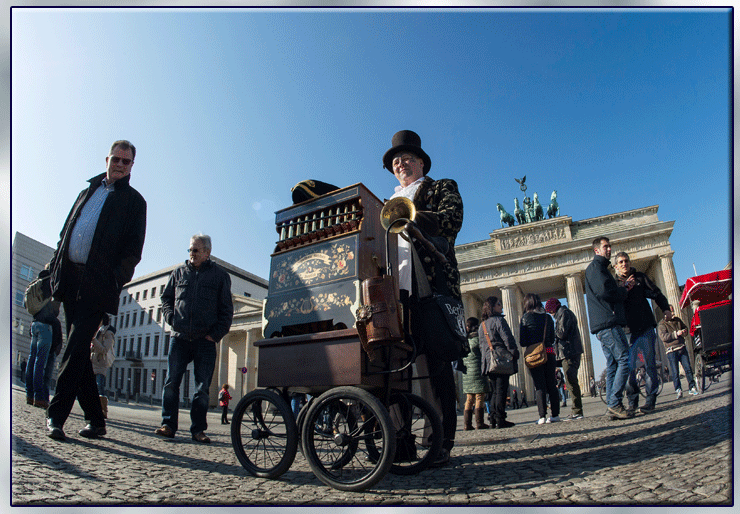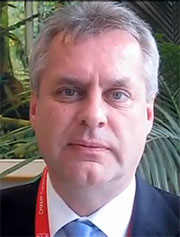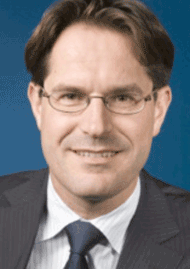 Words
& Music—While Miros, the hurdy-gurdy man, plays in spring-like
weather in front of the Brandenburg Gate in Berlin, Germany, delegates
at IATA World Cargo Symposium in Shanghai learned that WCS would be held
in Berlin next year. Words
& Music—While Miros, the hurdy-gurdy man, plays in spring-like
weather in front of the Brandenburg Gate in Berlin, Germany, delegates
at IATA World Cargo Symposium in Shanghai learned that WCS would be held
in Berlin next year.
After several sessions were presented in
Mandarin this week, some wonder whether the same will hold true for a
2016 event spoken in German . . .

IATA
World Cargo Symposium (at least the public portion) concluded Thursday,
with the morning dedicated to further “subject matter tracks,”
while the afternoon belonged to the closing plenary.
The “China International – Entering
Chinese Market” track—in the English language—was all
about entering, accessing, and competing in the Chinese air transport
market.
China as the current world’s largest
economy is a market forwarders, integrators, and airlines cannot do without.
 Ulrich
Ogiermann, (left) chief officer cargo at Qatar, provided invaluable insights
about the challenges foreign enterprises face when seeking access to the
vibrant Chinese market and the strategies to employ in order to cover
the specific needs of this market as well as making Chinese business a
sustainable and lasting one. Ulrich
Ogiermann, (left) chief officer cargo at Qatar, provided invaluable insights
about the challenges foreign enterprises face when seeking access to the
vibrant Chinese market and the strategies to employ in order to cover
the specific needs of this market as well as making Chinese business a
sustainable and lasting one.
 Carlos
Tornero, IATA legal counsel, briefed the audience about freedoms of the
air and current developments in regard to Open Sky agreements as well
as multilateral agreements. Carlos
Tornero, IATA legal counsel, briefed the audience about freedoms of the
air and current developments in regard to Open Sky agreements as well
as multilateral agreements.
Gert-Jan Jansen, (right) managing director,
Seabury Group provided some background about future trends and developments
in China’s air cargo market while Liao Zhi Yong, IATA manager Business
Process and Standards, outlined the entry requirements for foreign forwarders
into the Chinese Market, the requirements for incorporating in China as
well as obtaining a Cargo agencyship.
The subject of partnering with existing
Chinese forwarding companies and thus expanding one’s reach into
China without setting up branches was explained by David Yokeum, CEO of
the WCA forwarding network of independent forwarders.
Action DGR
& Cargo Ops Standout
Topping the list of important tracks were
“Cargo Operations and Handling” and the “Dangerous Goods”
tracks.
The Cargo Operations and Handling track
featured some high-caliber industry expertise from Emirates Manager Cargo
Global Operations Pichuyer Balasubramanian, BFS GM Cargo David Ambridge,
Air Canada VP Cargo Lise-Marie Turpin, and Nordisk VP Industry Affairs
Bob Rogers.
This was all about handling—best practices
to be employed, industry and customer expectations, legal and operational
challenges, as well as how to deal with and properly streamline the increasingly
complex processes of handling.
Chaired by David Ambridge, COAG (IATA Cargo
Operations Advisory Group) delivered an update and benchmarked the progress
and achievements since WCS 2014 in LAX, which included detailed outlines
regarding the implementation of IGOM (IATA Ground Operations Manual),
the adaption of the SGHA (IATA Standard Ground Handling Agreement) to
a much needed modernization, and the Facility Capability Matrix.
Briefly touched were the subjects of air
mail and its future in the times of e-commerce as well as an update about
the most neglected part in airline operations: The ULD. Delivered by Bob
Rogers of Nordisk, this was essentially an expanded version of the update
delivered during Wednesday’s “Regulations” track.
A panel discussion covered “Supply
Chain Optimization” and drove a lively exchange of arguments and
down-to-the roots work on how to achieve the 48 hours reduction in transit
time IATA had proposed.
The Dangerous Goods Track was dedicated
to the most controversial and disputed issue in air transport currently:
The transport of Lithium batteries by air.
Teun Muller from the Dutch Ministry of Infrastructure
provided a state-of-the industry runabout, focusing on the switch to “Competency
Based Training” (CBT) currently underway; the recommendations made
by the multidisciplinary Working Group on Lithium batteries by air and
the changes that took place in the multimodal UN Recommendations.
Competency Based Training or CBT is one
of the industry’s high hopes in order to improve compliance with
the regulations and avoid accidents: A combination of knowledge, skills
and attitude will, at least in theory, result in a (more) superior job
performance. As Mr. Muller explained, CBT is function driven—main
benefits are the support of SMS (Safety management Systems) and improved
on-the-job performance, and is designed to ensure that trainees can perform
the job at hand.
Further restrictions loom on the horizon
for shippers of Lithium batteries. For the time being, while further restrictions
applicable to Lithium batteries packed with or installed in equipment
are still disputed at the UN level, the exemption from having equipment
with so-called excepted batteries installed to be marked and documented
will be further restricted as no more than two packages per consignment
will be permitted to be shipped without the Lithium Battery handling label
identifying the nature of the cargo to the carrier.
Jason Abbott, director Engineering at AmSafe
Bridport answered what was probably the most pressing question of the
audience and industry: What can be done to mitigate the risks of shipping
Lithium batteries by air? In a detailed and knowledgeable presentation,
Mr. Abbott provided insight about the efficiency of both passive and active
fire containment systems—passive containments, such as thermal covers
(FCC), and active containments such as fire resistant cargo Containers
(FRC), are able to contain a fire for up to six hours—likely sufficient
time to divert the aircraft and make a safe landing, thus avoiding fatalities
as in the case of UPS006 in 2010.
 Peter Hunt, (left) Airline Ground Safety
manager for Cathay Pacific Airlines delivered a likewise knowledgeable
presentation about Risk Mitigation Strategies. He did not fail to emphasize
at the very beginning of his presentation that “Lithium batteries
are everywhere”—and, especially in the case of Hong Kong,
this means they’re also in the mail, mostly undeclared, and often
counterfeit.
Peter Hunt, (left) Airline Ground Safety
manager for Cathay Pacific Airlines delivered a likewise knowledgeable
presentation about Risk Mitigation Strategies. He did not fail to emphasize
at the very beginning of his presentation that “Lithium batteries
are everywhere”—and, especially in the case of Hong Kong,
this means they’re also in the mail, mostly undeclared, and often
counterfeit.
The issue of intentionally undeclared or
misdeclared shipments by willfully non-compliant shippers was addressed
by Mr. Hunt in no unclear words.
Last but not least, Dave Brennan, assistant
director Special Cargo Standards, explained the options regarding “Automation
to improve customer experience, taking the paper out of the (DG Shipping)
process.”
e-cargo &
other final tracks
The e-cargo track was, naturally, all about
e-cargo. Speakers and panelists represented the drivers of IT development
throughout the industry such as Uwe Glaser, Cargomind; Scott Sangster
and Jos Nuijten from Descartes; Sandeep Fernandes, Mercator; and Thilo
Schaefer, Lufthansa.
Whether it was “Behavior of the digital
customer,” “e-link: delivering great customer experience,”
or the “Role of Cargo 2000 in building a Digital Industry”:
No digital stone was left unturned.
A panel discussion “What is the next
step in e-Cargo transformation” identified the current state of
digital processes within the industry and provided a look at what is to
come and how it will affect the cost base, interaction with the customers
and other stakeholders, as well as streamline efficiency.
Subtitled “Thriving in the Digital
Age: Elevated Experiences, Interactions and Analytics,” this track
was about opportunities and chances as well as synergies, cost reductions,
and efficiency gains created by modern software solutions in the cargo
industry.
Exit Doors
To The Left
The overabundance of compressed subject
matter information may have worn out the delegates—attention to
mobile devices went up again during the closing plenary—among those
who participated, at least, since many delegates had either already left
or were quietly conducting business in the corners.
James Woodrow, director Cargo at CX and
chairman of the IATA Cargo Committee, provided a brief update about the
major results from the executive meetings, which took place during the
WCS—the CES Cargo Executive Summit, the Cargo Committee meeting,
and the C2K Board meeting.
Again, the most notable message Mr. Woodrow
sent was about the omnipresent Lithium batteries.
Stating “IATA can’t do it alone,”
Mr. Woodrow called for greater efforts and diligence all throughout the
supply chain and involving all stakeholders; another major result of the
executive meetings were resolutions to further push e-freight and in particular
the e-AWB.
While obviously many attendees found the
lengthy FACES session about “Identifying and nurturing the future
leaders of air cargo” overly long, attention went up when it was
time for the “innovation awards.” These were, who would have
thought, presented by Des Vertannes, former IATA Head of Cargo and currently
un-retired from his retirement just a year ago.
A rather unintended consequence of Mr. Vertannes
presentation might have been that Mr. Hughes, IATA’s current head
of cargo, looked rather dull compared to the much more lively Des Vertannes.
FACES finally kicked off and miraculously, all three finalists (out of
25 candidates in total) who had been invited to Shanghai came from the
Netherlands—something which prompted Mr. Vertannes to underscore
that IATA had no hand in that.
The three finalists were:
CANTrack by
Floris Kleijn, CHEP Aerospace Solutions;
CLIVE by Niall
Van de Wouw, CLIVE;
Cargo Claims
by Kiona van de Burg, Cargo Hub
The 1st prize award of $20,000 USD was won
by CANTrack of Chep Aerospace Solutions, featuring a ULD Tracking solution
powered by small solar panels generating the power for OnAsset ULD tracking
devices, which will avoid the cumbersome process of recharging batteries
or replacing them frequently.
IATA announced the location of the next
WCS in March 2016; this time, it will be in Berlin, Germany, and we are
eager to see whether IATA will continue the practice of providing tracks
in the local language.
Another update came after WCS 2015 had already
been wrapped up: The WCS app (which most delegates seem to have installed
on their mobile devices) provided the following announcement:
“As a WCS delegate, you may have
received a mobile charging device as a giveaway. Please be sure to pack
this device in your carry-on.
“In accordance with rules, do not
place in your checked luggage.
“Have a safe flight!”
FlyingTypers must categorically
deny that our report
of the WCS Power bank giveaway two days ago had anything to do with this
announcement.
Don Vito
|





